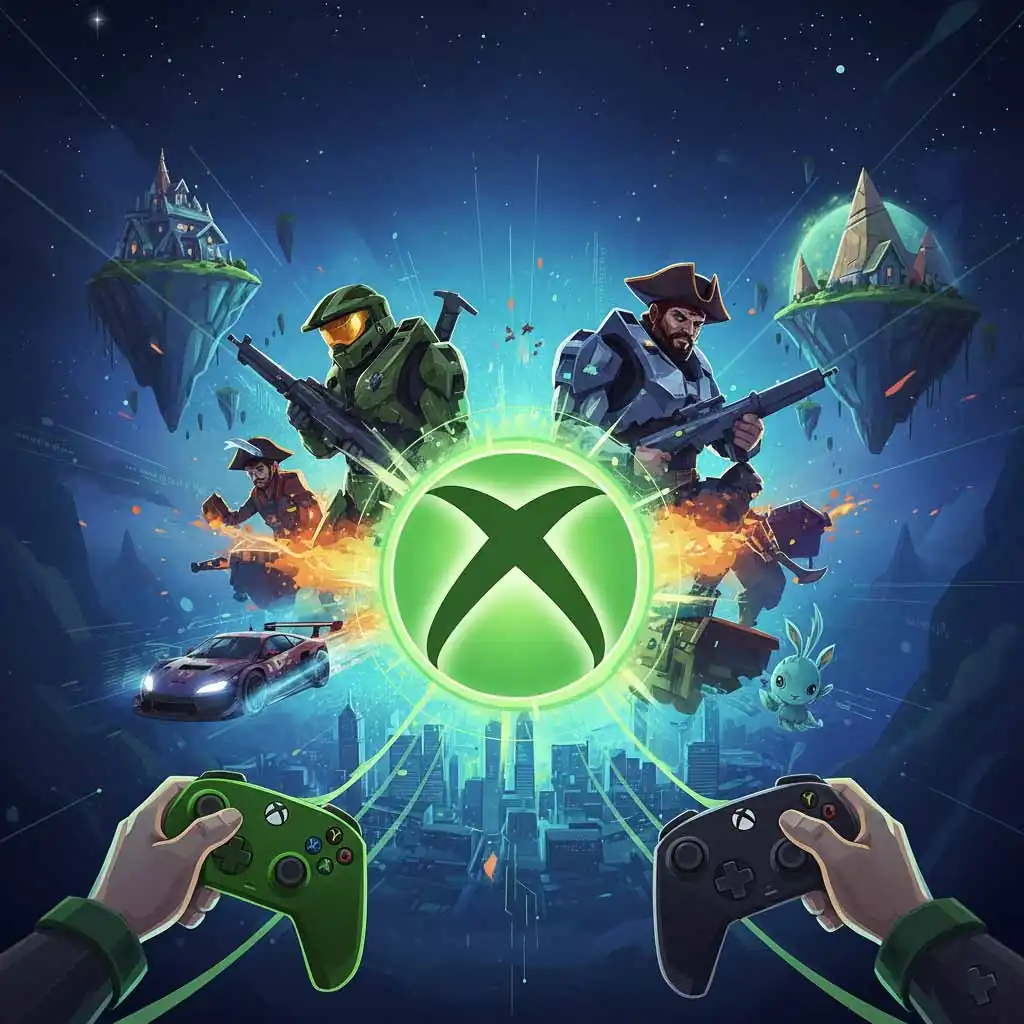Microsoft Xbox story intro
In the late 1990s, the world of digital entertainment was undergoing a seismic shift. The PC was king in the home office, but in the living room. A new monarch was rising: the video game console. At the time, Sony’s PlayStation dominated the market, transforming gaming from a niche hobby into a global cultural phenomenon. Sony had not only captured the hearts of gamers but was also positioning its upcoming PlayStation 2 as a complete digital entertainment hub, a device that could play games, movies, and music. This posed a direct and existential threat to Microsoft. A company whose entire empire was built on the Windows operating system. This how how Microsoft Xbox story began.
If the living room became a space dominated by a competitor’s hardware, it could eventually sideline Windows and all the applications that ran on it. The central question for Microsoft became: how could they, a software powerhouse with no experience in building consumer electronics, possibly compete in a market so fiercely controlled by giants like Sony and Nintendo? This article promises to take you on a deep dive into the untold story of the Microsoft Xbox. Revealing the key players, their audacious vision, and the monumental risks they took to enter the console wars.
Microsoft’s Digital Dilemma: A Call to Action
The late ’90s were a period of immense change in the tech industry. While Microsoft was flying high with the ubiquity of Windows, the rise of the internet and the growing sophistication of consumer electronics presented new challenges. The PC was the go-to device for productivity, but the living room, with its television and stereo system, was the domain of entertainment. A new type of device was emerging, a convergence of gaming and entertainment. Sony was at the forefront of this evolution with its PlayStation, and its successor, the PlayStation 2, was designed to be much more than a gaming machine. It was a digital media hub, and it presented a clear and present danger to Microsoft’s aspirations for controlling the digital lifestyle of consumers.
The fear within Microsoft’s halls was palpable. A “what if” meeting became the catalyst for action. What if Sony succeeded in making the PlayStation 2 the centerpiece of home entertainment? What if consumers no as often used a PC for their digital needs? This fear drove a small group of engineers to brainstorm a solution. Their initial idea was simple yet revolutionary: to create a dedicated gaming machine built on Microsoft’s own DirectX graphics technology, a technology that was already the industry standard for PC games. The working name for this project was the “DirectX Box,” a name that would soon be shortened to something much more memorable and iconic: Xbox. The name itself signaled its core identity—a box powered by DirectX, a gaming machine for the living room.
Microsoft Xbox story and the Original Team: A Group of Rebels and Visionaries
The creation of the Xbox was not a top-down mandate from Bill Gates or Steve Ballmer. It was the product of a small, rebellious team of engineers and visionaries who believed in the project with almost fanatical passion. At the heart of this team was Ed Fries, the head of Microsoft’s game division. He understood the gaming market and the strategic importance of this new venture. But he couldn’t do it alone. He enlisted a group of like-minded individuals who became known as the “four horsemen” of the Xbox project. These were not corporate yes-men; they were a motley crew of game developers and engineers who saw the world not through the lens of Microsoft’s corporate structure but through the eyes of a gamer.
Did You Know?
The original Xbox team had to use a makeshift office space in a building at Microsoft that was so far off the beaten path they nicknamed it “the dungeon.” This physical isolation fostered their close-knit, rebellious culture.
They operated with a “skunkworks” mentality, holding clandestine meetings away from the prying eyes of the corporate machine. They knew their idea was radical and would face immense resistance from a company that had always been about software, not hardware. The culture clash was inevitable. This small, scrappy team was accustomed to the agile, fast-paced world of game development, which was a stark contrast to the slow, methodical, and often bureaucratic nature of Microsoft’s internal processes. Their shared goal, however, transcended these differences: they were determined to create a powerful, developer-friendly console that was more akin to a personal computer than a traditional, closed-off console.
The Core Team
| Name | Role |
|---|---|
| Ed Fries | Head of Microsoft’s game division and key champion of the project. |
| Kevin Bachus | One of the “four horsemen” and a core member of the Xbox team. |
| Seamus Blackley | One of the “four horsemen” and a core member of the Xbox team. |
| Otto Berkes | One of the “four horsemen” and a core member of the Xbox team. |
The Vision and The Goal: A Living Room Invasion
The Xbox project was born out of fear, but it was fueled by an ambitious vision. The team’s primary goal was to create the “ultimate gaming machine,” a console that would not only be more powerful than its competitors but would also serve as the central hub of digital entertainment in the home. Their objectives were clear and focused, as highlighted below.
The Four Pillars of the Xbox
| Core Goal | Description |
|---|---|
| Power | To build a true powerhouse, a machine capable of delivering the most stunning graphics and the smoothest gameplay to attract top-tier developers. |
| Developer-Centric | To use familiar PC architecture (DirectX) to make it easier and cheaper for developers to create games, a strategic move against rival consoles. |
| Online Gaming | To build a robust, seamless, and user-friendly online service from the beginning, which would become the groundbreaking Xbox Live. |
| A Foot in the Door | To secure a presence in the living room and ensure that no single company could control the future of home entertainment. |
The Pitch to the Titans: Getting Bill Gates and Steve Ballmer on Board
The most legendary moment in the Xbox’s origin story is the pitch meeting to Microsoft’s highest-ranking executives: Bill Gates and Steve Ballmer. The team of four horsemen, along with Ed Fries, stood before the two titans of tech, ready to present their radical idea. The atmosphere was tense. Gates, ever the software purist, was deeply skeptical. He saw a hardware business as a low-margin, high-risk venture. The executives’ initial reaction was a resounding no. Gates was worried about the billions of dollars it would take to compete with Sony and Nintendo, and he didn’t see a clear path to profitability.
Did You Know?
The original proposal for the Xbox team was to make a Microsoft-branded PC that would sit in the living room and serve as a gaming machine. The idea was to keep the Windows brand at the forefront. The “DirectX Box” concept was a strategic departure from this, focusing solely on the gaming experience.
The team, however, had a brilliant ace up their sleeve. Instead of framing the Xbox as a competitor to Windows, they reframed it as its protector. They explained that if Sony’s PlayStation 2 became the central hub of the living room, it would eventually threaten the dominance of the PC. The Xbox, they argued, was not a distraction from Windows; it was a necessary and strategic defense. This was the turning point. By framing the project as a defensive measure rather than an offensive one, they finally got through to Gates. In that pivotal moment, he gave the green light, a decision that would commit billions of dollars to a project that was, at the time, a monumental gamble.
Building the Beast: From Concept to Reality
With the funding secured, the real work began: building the machine. The hardware design was a Herculean task. The team wanted to pack an enormous amount of power into a small, elegant box. This led to a constant struggle with heat dissipation. The solution was a massive cooling system, a challenge that contributed to the console’s famously large size and weight. The decision to include a hard drive was another huge risk. At the time, consoles used memory cards to save game progress. The Xbox team’s foresight in including a hard drive was groundbreaking, enabling more robust features and saving the need for external storage.
The software development was equally challenging. The team had to create a new operating system that was simple enough for a console but powerful enough to handle complex games and online features. They worked tirelessly to create a user-friendly interface that would make the console easy to navigate for non-tech-savvy users.
The name, “Xbox,” was finally settled upon. The marketing team recognized the power of its simplicity and its direct connection to the underlying technology. The brand was built on an aggressive, edgy marketing campaign that targeted a new generation of gamers. Then there was the controller. The initial “Duke” controller was notoriously large and cumbersome. It was a source of great debate and a major point of criticism during the console’s initial reveal. It was a perfect symbol of the “American” design philosophy: bigger is better. While it was widely panned, the team would eventually create a more compact, revised version.
The Microsoft Xbox story launch: The Red Carpet and the Competition
The launch of the Xbox was a spectacle. Microsoft, a company known for software launches, pulled out all the stops for its new consumer product. The marketing campaign was aggressive and memorable, culminating in a star-studded launch event. The most important part of any console launch is its game lineup, and the Xbox team knew this. They had a strong roster of titles, but one stood out above all others: Halo: Combat Evolved. Developed by Bungie, this first-person shooter was the killer app that the Xbox needed. It showcased the console’s power and introduced a new kind of storytelling and gameplay to the genre. Halo would not only define the Xbox but would also become a cultural touchstone for a generation of gamers.
The Competition at Launch
| Microsoft Console | Major Competitors |
|---|---|
| Xbox (Launched 2001) | Sony PlayStation 2 (Launched 2000) Nintendo GameCube (Launched 2001) |
The Xbox went head-to-head with two formidable competitors: the Sony PlayStation 2, which already had a massive market share, and the Nintendo GameCube, which appealed to a younger, more family-friendly audience. The initial reception to the Xbox was a mixed bag. Critics praised its power and the groundbreaking Xbox Live service, but they were also skeptical of its size and its initial lack of a diverse game library. The console sold slowly at first, and for a time, it seemed as if Microsoft’s massive bet might not pay off.
Legacy and Impact: The Xbox’s Enduring Story
The original Xbox was a commercial success, but its true legacy is not measured in sales figures alone. It fundamentally changed the gaming industry. It proved that a company without a history in console hardware could not only compete but could also innovate. The introduction of Xbox Live was a game-changer. It was the first unified, subscription-based online service for a console, and it completely revolutionized multiplayer gaming. It made online play a seamless, integrated experience and established a model that every competitor would eventually follow.
Did You Know?
The original Xbox had a hard drive that was 8 GB, a feature that was almost unheard of in consoles at the time. This hard drive was a crucial component of the Xbox Live service and enabled features like game saves and downloadable content.
The original Xbox was the foundation for a gaming empire. It led to the hugely successful Xbox 360, which continued the online revolution and was a major player in the high-definition era. The Xbox One and the current generation of Series X/S consoles have cemented Microsoft’s place as one of the “Big Three” in gaming. The Xbox ecosystem, with its Game Pass subscription service and focus on cloud gaming, is a testament to the forward-thinking vision of that original team. The story of the Xbox is a perfect example of a monumental risk that paid off. The tale of a small team of rebels who, with a powerful idea, changed the course of video game history.
Frequently Asked Questions About the Microsoft Xbox Story
What was the main reason Microsoft created the Xbox?
Microsoft created the Xbox primarily out of fear that Sony’s PlayStation 2 would become the dominant digital entertainment hub in the living room, potentially sidelining the Windows operating system and its ecosystem. The Xbox was a defensive maneuver to ensure Microsoft had a presence in that crucial market.
Who were the key people behind the original Xbox project?
The core team, often called the “four horsemen,” consisted of Kevin Bachus, Seamus Blackley, and Otto Berkes. They were led by Ed Fries, who was the head of Microsoft’s game division and a crucial champion of the project.
Why was the original Xbox called the “DirectX Box”?
The initial working name was “DirectX Box” because the console was based on Microsoft’s own DirectX graphics technology, which was the standard for PC games. The name was later shortened to “Xbox” for better brand recognition.
What significant innovation did the original Xbox introduce?
The most significant innovation was the creation of Xbox Live, a unified and robust online service for multiplayer gaming. It set the standard for online console gaming and changed the way people played with friends and competitors.
What was the “Duke” controller?
The “Duke” was the nickname for the original Xbox controller. It was notoriously large and was a source of much controversy and criticism due to its size and weight, especially when compared to its rivals.
How did the Xbox team convince Bill Gates and Steve Ballmer to approve the project?
They convinced the executives by reframing the project. Instead of presenting it as a risky hardware venture, they presented it as a strategic move to protect the Windows ecosystem from being displaced by Sony’s growing influence in the living room.
What role did Halo: Combat Evolved play in the Xbox’s launch?
Halo: Combat Evolved, an exclusive launch title that earned high acclaim, showcased the console’s power, drove initial sales, and became the brand’s flagship title.
How did the Xbox change the video game industry?
The Xbox changed the industry by proving that a new player could enter the console market and succeed. It revolutionized online gaming with Xbox Live, and its use of a hard drive and PC-like architecture influenced future console design.
What was the main competition for the original Xbox?
The original Xbox’s main competitors were the Sony PlayStation 2, which dominated the market, and the Nintendo GameCube, which appealed to a different segment of the market with its family-friendly games.
Was the original Xbox a commercial success?
While it sold slowly at first and faced intense competition. The original Xbox became a commercial success in the long run. It established Microsoft as a major player in the console market and laid the groundwork for its highly successful successors.
Microsoft Xbox story conclusion
The story of the Microsoft Xbox is more than just the creation of a video game console. It’s a tale of corporate foresight, technological innovation, and the power of a small team with a radical idea. Born out of a strategic necessity to protect Microsoft’s core business. The Xbox project was a monumental gamble that could have easily failed. The decision to commit billions of dollars to a new hardware venture. A space where Microsoft had no prior experience, was a bold move that paid off in the long run.
The original Xbox not only established Microsoft as a major force in the video game industry but also permanently changed the way we play. From the groundbreaking Xbox Live service to the development of a powerful and developer-friendly machine. The legacy of the Xbox endures, a testament to how a small team of rebels within a tech giant changed the course of video game history.
Explore the Full Xbox Universe
This article is just the beginning of your journey. Ready to uncover the full story? Visit our main Xbox hub for everything you need, with deep dives into the console’s history, top games, and all the features that make it a gaming powerhouse.


















